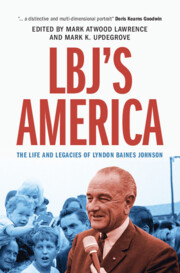Book contents
- LBJ’s America
- LBJ’s America
- Copyright page
- Contents
- Illustrations
- Contributors
- Introduction
- Chapter 1 Power and Purpose: LBJ in the Presidency
- Chapter 2 LBJ and the Contours of American Liberalism
- Chapter 3 Lyndon Johnson and the Transformation of Cold War Conservatism
- Chapter 4 The Great Society and the Beloved Community: Lyndon Johnson, Martin Luther King Jr., and the Partnership That Transformed a Nation
- Chapter 5 Lyndon Johnson, Mexican Americans,and the Border
- Chapter 6 The War on Poverty: How Qualitative Liberalism Prevailed
- Chapter 7 LBJ’s Supreme Court
- Chapter 8 “If I Cannot Get a Whole Loaf, I Will Get What Bread I Can”: LBJ and the Hart–Celler Immigration Act of 1965
- Chapter 9 “It’s Always Hard to Cut Losses”: The Politics of Escalation in Vietnam
- Chapter 10 Lyndon Johnson and the Shifting Global Order
- Chapter 11 “Through a Narrow Glass”: Compassion, Power, and Lyndon Johnson’s Struggle to Make Sense of the Third World
- Afterword: LBJ’s America
- Acknowledgments
- Notes
- Index
Chapter 9 - “It’s Always Hard to Cut Losses”: The Politics of Escalation in Vietnam
Published online by Cambridge University Press: 19 October 2023
- LBJ’s America
- LBJ’s America
- Copyright page
- Contents
- Illustrations
- Contributors
- Introduction
- Chapter 1 Power and Purpose: LBJ in the Presidency
- Chapter 2 LBJ and the Contours of American Liberalism
- Chapter 3 Lyndon Johnson and the Transformation of Cold War Conservatism
- Chapter 4 The Great Society and the Beloved Community: Lyndon Johnson, Martin Luther King Jr., and the Partnership That Transformed a Nation
- Chapter 5 Lyndon Johnson, Mexican Americans,and the Border
- Chapter 6 The War on Poverty: How Qualitative Liberalism Prevailed
- Chapter 7 LBJ’s Supreme Court
- Chapter 8 “If I Cannot Get a Whole Loaf, I Will Get What Bread I Can”: LBJ and the Hart–Celler Immigration Act of 1965
- Chapter 9 “It’s Always Hard to Cut Losses”: The Politics of Escalation in Vietnam
- Chapter 10 Lyndon Johnson and the Shifting Global Order
- Chapter 11 “Through a Narrow Glass”: Compassion, Power, and Lyndon Johnson’s Struggle to Make Sense of the Third World
- Afterword: LBJ’s America
- Acknowledgments
- Notes
- Index
Summary
When Lyndon Johnson took the United States into large-scale war in Vietnam in 1965, he did so despite deep misgivings on the part of numerous close associates, including his vice president and senior Senate Democrats, as well as key allied governments. Johnson himself frequently expressed doubts about the prospects in the struggle, even with the commitment of major US combat troops and heavy air power. Yet he took the plunge, despite the fact that some part of him suspected – correctly – that the war would ultimately be his undoing. Why he did so is harder to explain than is often suggested, but it’s not inexplicable. At each step, escalation represented the path of least political resistance for him. Thus although Johnson may have been a doubting warrior, he was also a determined one, from his first day in office to his last. He stayed the course even as domestic opposition grew in 1967 and 1968, and even as his principal subordinate on the war, Secretary of Defense Robert McNamara, grew disillusioned. In January 1969, Johnson left Washington, a man broken by a war he didn’t want but felt compelled to wage.
Keywords
- Type
- Chapter
- Information
- LBJ's AmericaThe Life and Legacies of Lyndon Baines Johnson, pp. 229 - 253Publisher: Cambridge University PressPrint publication year: 2023



